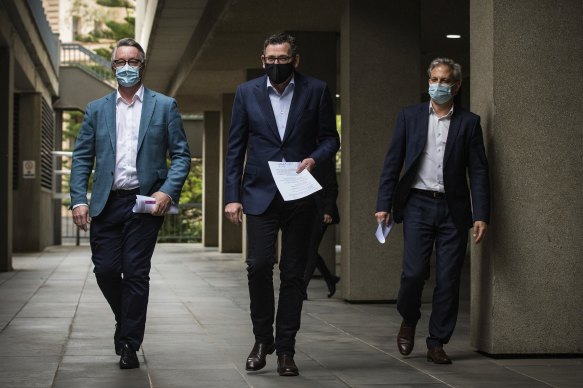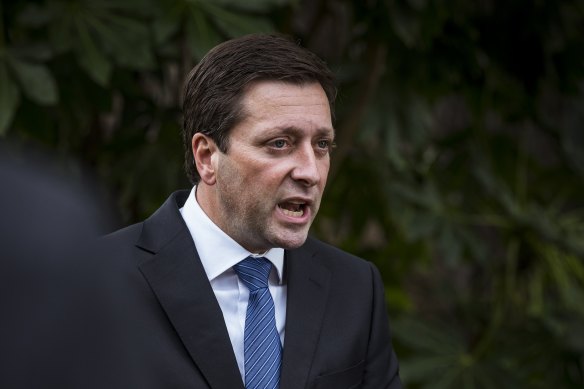This was published 3 years ago
‘Home stretch’: Government reveals road map out of lockdown, shuts down large slices of public life to the unvaccinated
By Sumeyya Ilanbey and Liam Mannix
Victoria has outlined a significantly slower and more cautious path out of COVID-19 lockdown than NSW, with only those who are fully vaccinated able to feel the benefit of easing restrictions and a timeline that stretches out to Christmas.
Even so, the Burnet Institute modelling on which the road map is based predicts up to 4000 infections per day, several thousand deaths and a hospital system stretched by new admissions at the end of December as freedoms increase.

Health Minister Martin Foley, Premier Daniel Andrews and Chief Medical Officer Brett Sutton on Sunday announced the road map out of COVID-19 restrictions. Credit: Darrian Traynor
Despite those projections, however, Premier Daniel Andrews declared on Sunday: “We are opening up, no doubt about that. There will be no turning back. We have to normalise this, we have to pass through this pandemic.”
To mitigate the worst of the harm, the modellers have suggested vaccines be mandatory for a significant number of Victorians including teachers, childcare workers, parents of childcare workers, hospitality workers and hospitality patrons. Chief Health Officer Brett Sutton said he was actively considering making these orders, with school and childcare staff prioritised for assessment.
The road map was welcomed by health experts, but Victoria’s business lobby groups say they are bitterly disappointed at the pace of reopening, adding that shop workers are bracing for an upsurge in customer aggression if they have to exclude unvaccinated customers. The Australian Hotels Association (AHA) said it was “gutted” by Sunday’s announcement.
Opposition Leader Matthew Guy said while he welcomed the government announcing its road map, the promised freedoms were “too harsh for too long”.
The easing of restrictions in Victoria will not begin until next week when 80 per cent of Victorians aged 16 and over are expected to be single-dose vaccinated, and then only with permission for people to play open-air, contactless sport such as golf and tennis.
School is likely to reopen on October 5 as year 12 students return to classrooms. From October 18 students in prep, grade 1 and grade 2 will also return but most are limited to only two days per week and the days are staggered to minimise the number of children in school at any time.
When the state reaches the 70 per cent fully vaccinated mark, likely on October 26, the five permitted reasons for leaving the home will no longer apply for residents of metropolitan Melbourne who are double-dosed. Up to 10 people will be allowed to gather but only outdoors, while pubs and clubs can open to 50 fully vaccinated people sitting in the open air.
Mr Andrews said the government was working towards having a “vaccine passport” working by then, allowing people’s vaccination status to show up when they scan the Services Victoria QR check-in code.
The most significant threshold comes when 80 per cent of eligible Victorians are fully vaccinated, likely on November 5. Then regional Victoria and Melbourne come under the same rules. Melburnians will be able to travel outside the city, and will be permitted to host 10 people at their houses, and 150 fully vaccinated people can dine indoors. Masks will still be required in indoor spaces. People who are fully vaccinated can return to work.
Crowds could return to the Melbourne Cup, on November 2, if the state reaches its 80 per cent double dose vaccination coverage ahead of the projected date.
“If we deliver it by Cup Day, or it’s really clear that we’re going to, then we’ll have options to have a crowd,” the Premier said. “I can’t say how big … but it’s a great goal. It’d be a great signal to the world, signal to the rest of the country that Victoria is open.”
If all goes well, by Christmas people should be able to host 30 visitors to their home.
“We cannot permanently suppress this virus,” Mr Andrews said on Sunday. “We have got to open the place up because remaining closed forever has its own cost.”
Chief Health Officer Brett Sutton said: “It is a long path still but it is absolutely right to consider it our home stretch.
“We would all like to already be at the settings that might apply for Christmas to see our friends and family overseas, to be able to gather in large groups, but there’s a long haul in front of us and there is a lot of work we still need to do collectively to protect ourselves, protect each other through that pathway.”
Despite the general push to ease restrictions, Health Minister Martin Foley said local and regional lockdowns might still be necessary. Geelong, Surf Coast Shire and Mitchell Shire were plunged into a seven-day lockdown from 11.59pm Sunday. There will not be a curfew.
“It remains a tightrope between ensuring that our health system is not overwhelmed but also being able to sustain us in our wellbeing and to protect us from those other harms that come from lockdown,” Mr Andrews said.
However, Mr Guy said: “The plan appears to be full of ifs, buts and maybes, and the plan to get kids back to school appears to be very long.
“The government is obsessed with locking us down until Christmas – to look at capacity limits that are not going to be able to work for businesses. To look at children returning very late in some instances, and have capacity limits and kilometre limits of 25 kilometres for weeks and weeks to come is not offering Victorians hope, that’s only a path for further lockdowns.”

Opposition Leader Matthew Guy says the road map “is too harsh for too long”. Credit:
But Michael Lydeamore, a Monash University researcher who has contributed to the Doherty Institute’s reopening modelling, said the government’s announcement was a good plan.
“It’s clearly reopening slowly, and I think that’s the right move – because it’s only going to go in one direction. You can’t turn this around. Once those cases go up, they are going to keep on going up, and no amount of locking it down is going to turn things around.”
The Premier announced all healthcare workers would be required to have received at least the first dose of their COVID-19 vaccine by October 15 or provide evidence they have an appointment to be immunised by November 1. He pointed to the “power” of mandatory jabs in the aged care sector where 98 per cent of the workforce had received at least one dose of the COVID-19 vaccine.
However, if modelling released by the government along with the plan is accurate, Christmas will come after a gruelling period for the state’s healthcare system — with worse to come. The Burnet Institute’s modelling predicts its road map out of lockdown has a more than one-in-two chance of exceeding the state’s hospital and intensive care capacity and will lead to the deaths of between 1455 and 3152 people.
“We know there will be a pandemic of the unvaccinated,” Premier Andrews said.
The Burnet Institute’s modelling predicts a first peak in daily average infections of between 1400 and 2900 in the last two weeks of October. In a quarter of simulations, hospital capacity is exceeded despite Melbourne being in lockdown.
A second larger peak is forecast for mid-December, caused by increased virus transmission as restrictions ease, before case numbers fall away.
Between July and December 2021, between 1455 and 3152 Victorians are projected to die of COVID-19 under the road map, including the 11 deaths in the current outbreak.
”[The road map] is not our health orders - they are our plan. These are what we’d like to do, these are our aspirations … based on evidence … but if our health system is asked to perform an impossible task we won’t ask them to do it,” Mr Andrews said.
“It’s going to get very tough and [healthcare workers] know that. It was tough last year, and this is going to be even harder, but at 80 per cent double dose there will never be a better time. As hard as it will be, there is no better time than to move through that gateway and move beyond this.”
Mr Andrews said Commonwealth officials indicated to national cabinet on Friday there would be “supply issues” with Pfizer in October, and all states and jurisdictions should expect fewer Pfizer doses throughout the month.
However, a spokesman for Operation COVID Shield said officials were finalising the October allocation with Pfizer, with two weeks to go until next month. State and territory governments are usually given at least four weeks’ notice on their monthly allocations.
Meanwhile, 66 local government areas in New South Wales have been downgraded from “extreme red zone” to “red zone”, meaning Victorians will be allowed to apply for a permit and return home to complete their 14-day isolation.
Stay across the most crucial developments related to the pandemic with the Coronavirus Update. Sign up for the weekly newsletter.
correction
An earlier version of this article said vaccines would be mandated for a range of industries. The Burnet Institute’s modelling, which the road map is based on, has an underlying assumption that vaccines will become mandatory for those sectors. The Chief Health Officer is actively considering those sectors and will make a decision soon.